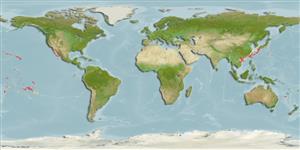>
Kurtiformes (Nurseryfishes, cardinalfishes.) >
Apogonidae (Cardinalfishes) > Apogoninae
Etymology: Apogon: Greek, a = without + Greek pogon = chin, beard (Ref. 45335).
More on author: Snyder.
Environment: milieu / climate zone / depth range / distribution range
Ecologie
marien rifbewoner; diepte 1 - 48 m (Ref. 58302). Tropical
Eastern Central Pacific: known only from the Hawaiian Islands and Johnston Island. Reports of occurrence in other Indo-West Pacific countries are questionable.
Grootte / Gewicht / Leeftijd
Maturity: Lm ? range ? - ? cm
Max length : 4.0 cm SL mannelijk / geslacht onbekend; (Ref. 40822)
Korte beschrijving
Determinatiesleutels | Morfologie | Morfometrie
Dorsale stekels (totaal) : 7; Dorsale zachte stralen (totaal) : 8 - 9; Anale stekels: 2; Anale zachte stralen: 8. Differs from other members of the A. erythrinus complex by having the following characteristics: from all others by having a much longer second dorsal fin spine, reaching to at least the base of third ray of second dorsal fin when depressed (spine in other species do not reach third ray); from A. indicus by having 14 pectoral fin rays (versus 13, rarely 12 or 14), and by lacking pigment on the dorsal surface of the caudal peduncle (present in A. indicus); from A. marquesensis by lacking scattered chromatophores on sides of caudal peduncle that extend anteriorly as a band from caudal fin base to vertical from ends of dorsal and anal fin rays (pigment extends forward as a band in A. marquesensis); from A. susanae by having pigment present on scale edges at front of second dorsal fin and sometimes along its base and scattered chromatophores on caudal fin base (absent in A. susanae) (Ref. 40822).
Found in shallow water and observed to be active only at night, near the bottom, and never far from its shelter (Ref. 27665). Benthopelagic (Ref. 58302).
Levenscyclus en paargedrag
Maturiteit | Voortplanting | Paaien | Eieren | Fecunditeit | Larven
Mouthbrooders (Ref. 240). Distinct pairing during courtship and spawning (Ref. 205).
Greenfield, D.W., 2001. Revision of the Apogon erythrinus complex (Teleostei: Apogonidae). Copeia 2001(2):459-472. (Ref. 40822)
Status op de Rode Lijst van het IUCN (Ref. 130435: Version 2024-1)
Gevaar voor de mens
Harmless
Gebruik door de mens
Tools
Speciale rapporten
Download XML
Internetbronnen
Estimates based on models
Preferred temperature (Ref.
123201): 23.8 - 28.2, mean 25.9 °C (based on 48 cells).
Fylogenetische diversiteitsindex (Ref.
82804): PD
50 = 0.5000 [Uniqueness, from 0.5 = low to 2.0 = high].
Bayesian length-weight: a=0.01445 (0.00680 - 0.03071), b=3.07 (2.89 - 3.25), in cm total length, based on LWR estimates for this (Sub)family-body shape (Ref.
93245).
Trofisch niveau (Ref.
69278): 3.8 ±0.59 se; based on food items.
Weerstandsvermogen (Ref.
120179): Hoog, minimale populatieverdubbelingstijd minder dan 15 maanden (tmax=0.3 (120 days)).
Fishing Vulnerability (Ref.
59153): Low vulnerability (10 of 100).
Nutrients (Ref.
124155): Calcium = 952 [94, 19,045] mg/100g; Iron = 9.11 [1.05, 60.08] mg/100g; Protein = 18.2 [14.3, 21.9] %; Omega3 = 0.107 [0.003, 3.480] g/100g; Selenium = 460 [12, 14,566] μg/100g; VitaminA = 1.94 [0.02, 180.42] μg/100g; Zinc = 14.7 [2.5, 60.1] mg/100g (wet weight);
